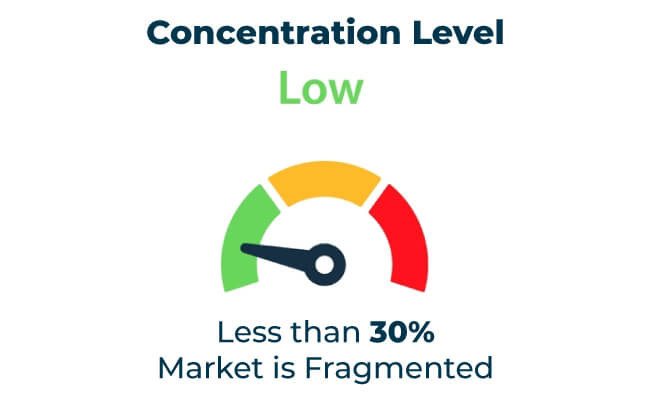The rigid food containers market is thriving as businesses and consumers demand durable, sustainable, and high-quality packaging solutions. Manufacturers are innovating with lightweight materials, advanced designs, and eco-friendly practices to meet the needs of various sectors, including food and beverage, retail, and logistics.
By 2035, the global rigid food containers market is projected to exceed USD 221.3 billion, growing at a compound annual growth rate (CAGR) of 1.9%.
Market growth is fueled by a shift towards sustainability and convenience. Companies aim to create reusable, recyclable, and functional containers that match the changing expectations of consumers. Collaboration with the leading industries will ensure that their products meet the environmental standards and food safety requirements.
| Attributes | Description |
|---|---|
| Projected Market Value (2025F) | USD 221.3 billion |
| Value-based CAGR (2025 to 2035) | 1.9% |
Exclusive Offer: 30% Off on Regional Reports
Get a free sample report and customize your regions for a 30% discount on your regional report!
Factors Driving Market Growth
Global Market Share & Industry Share
| Category | Market Share (%) |
|---|---|
| Top 3 Players (Amcor, Berry Global, Tupperware) | 16% |
| Rest of Top 5 Players (Silgan Holdings, Huhtamaki) | 06% |
| Next 5 of Top 10 Players | 07% |
Type of Player & Industry Share
| Type of Player | Market Share (%) |
|---|---|
| Top 10 Players | 29% |
| Next 20 Players | 45% |
| Remaining Players | 26% |

Year-on-Year Leaders
Check Free Sample Report & Save 40%!
Select your niche segments and personalize your insights for smart savings. Cut costs now!
Emerging markets in Asia-Pacific, Africa, and Latin America present significant export potential. Rising urbanization, increased disposable incomes, and a growing packaged food sector drive demand for high-quality and sustainable rigid food containers. Exporters who align with regional preferences and regulatory requirements can capture new opportunities.
| Region | North America |
|---|---|
| Market Share (%) | 30% |
| Key Drivers | Strong focus on sustainability and food safety standards. |
| Region | Europe |
|---|---|
| Market Share (%) | 35% |
| Key Drivers | Advanced recycling infrastructure and eco-conscious consumers. |
| Region | Asia-Pacific |
|---|---|
| Market Share (%) | 25% |
| Key Drivers | Urbanization and rising demand for packaged foods. |
| Region |
Other Regions |
|---|---|
| Market Share (%) | 10% |
| Key Drivers | Affordable, reusable solutions gain traction in emerging markets. |
The rigid food containers market will expand through advancements in eco-friendly materials, smart designs, and customization. Companies that embrace automation and partner with e-commerce platforms will strengthen their market position. Emerging markets and global trade opportunities will unlock additional growth potential.
| Tier | Key Companies |
|---|---|
| Tier 1 | Amcor, Berry Global, Tupperware |
| Tier 2 | Silgan Holdings, Huhtamaki |
| Tier 3 | Sealed Air, Genpak |
The rigid food containers market is poised for sustained growth as sustainability, convenience, and technological innovation drive demand. Companies that invest in eco-friendly practices, advanced manufacturing, and emerging markets will secure leadership positions. Automation and recycling advancements will further enhance efficiency and environmental impact.
Key Definitions
Abbreviations
Methodology
This report integrates primary research, secondary data, and expert insights. Analysts validated findings through interviews with industry professionals and end-users to ensure a comprehensive market perspective.
Market Definition
The rigid food containers market includes the development, production, and use of durable packaging solutions for food storage, transportation, and retail. These containers prioritize food safety, sustainability, and convenience.
Rigid food containers are durable packaging solutions made from materials like plastic, glass, and metal. They are designed to store, protect, and transport food safely.
Sustainability is crucial as consumers and governments demand eco-friendly packaging that minimizes waste and environmental impact. Companies are focusing on recyclable, compostable, and lightweight materials to meet these expectations.
The retail and foodservice industries are the largest users, relying on these containers for fresh produce, ready-to-eat meals, and takeout. The household and industrial sectors also contribute significantly.
E-commerce platforms, especially food delivery services, have increased the demand for rigid food containers that are sturdy, safe, and visually appealing.
Smart packaging, biodegradable materials, and high-barrier technologies are driving innovation, helping to improve food safety, shelf life, and sustainability.
Explore Packaging Formats Insights
View Reports
Thank you!
You will receive an email from our Business Development Manager. Please be sure to check your SPAM/JUNK folder too.